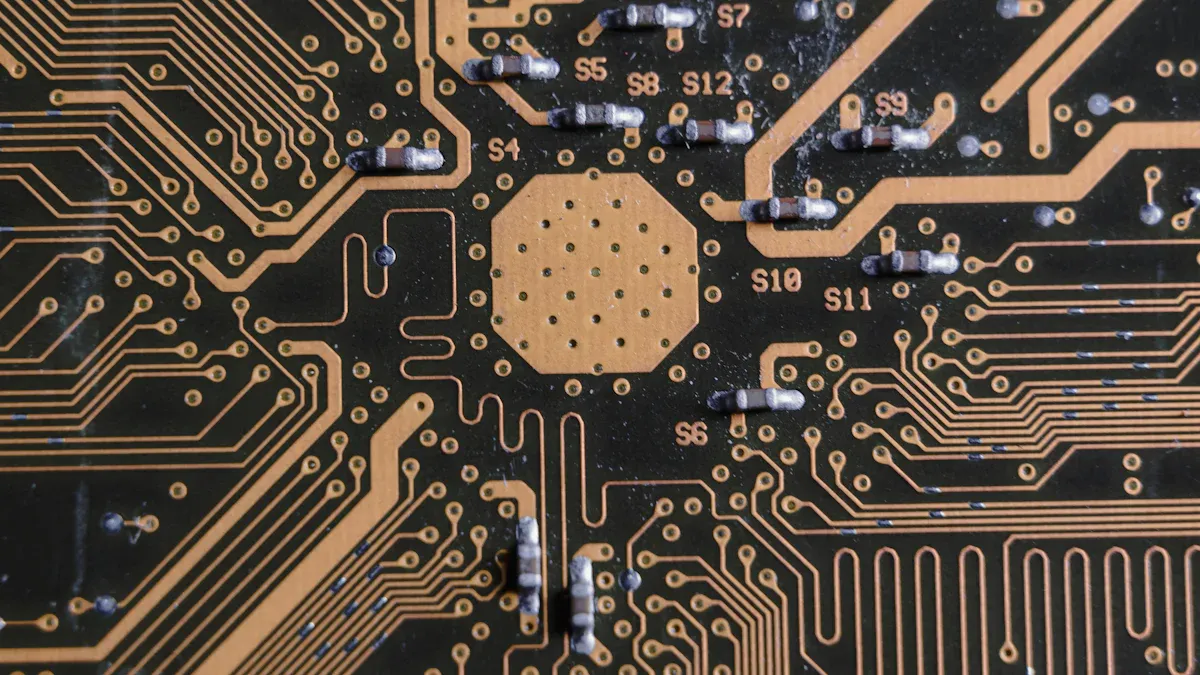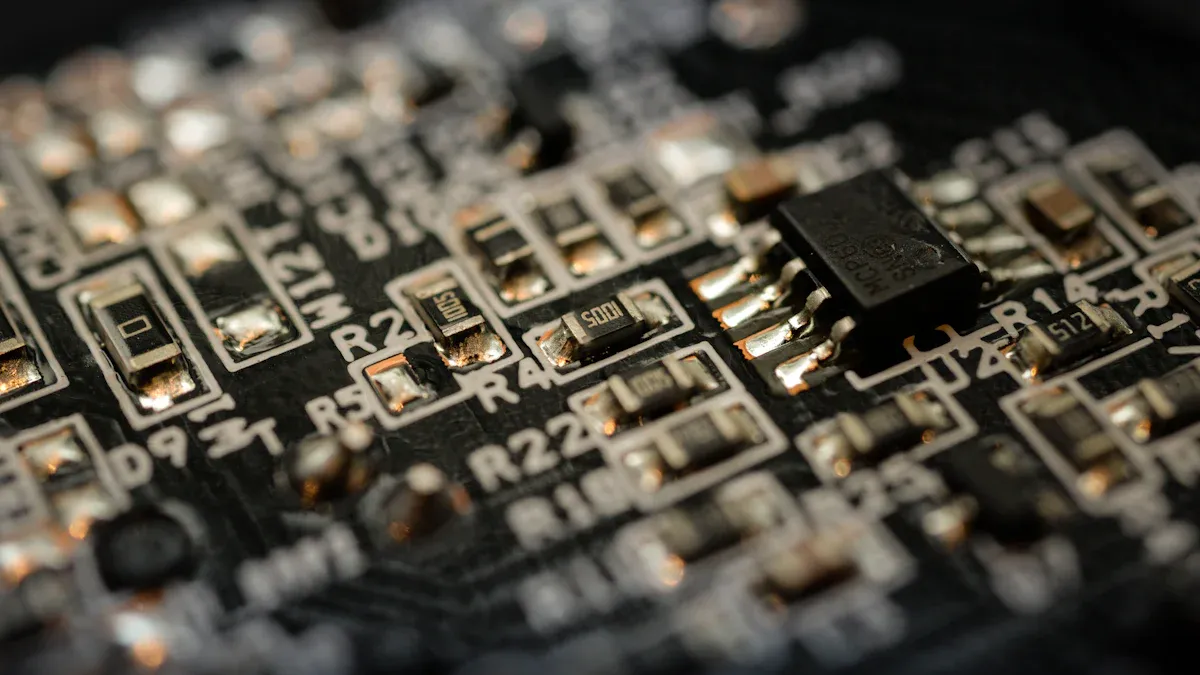
In epitaxy, achieving high-quality results requires precise tools. The GRAPHITE SUSCEPTOR plays a crucial role in this process, particularly in MOCVD equipment. Coated with silicon carbide (SiC), these susceptors provide exceptional thermal stability. Their outstanding chemical resistance and durability make them indispensable for semiconductor manufacturing, guaranteeing consistent and reliable performance.
Key Takeaways
- Piezas de grafito de siC help spread heat evenly. This makes fewer mistakes and better semiconductors during growth.
- Checking and cleaning SiC-coated parts often is important. Look for damage or dirt to keep them working well and lasting longer.
- Buying SiC-coated parts saves money over time. They last longer, need fewer changes, and reduce delays, making them a smart choice for making semiconductors.
The role of GRAPHITE SUSCEPTOR in MOCVD equipment
Carrier and heater functions
In MOCVD equipment, the GRAPHITE SUSCEPTOR serves as both a carrier and a heater. You rely on it to hold the substrate securely during the epitaxial growth process. Its design ensures stability, even under high temperatures. As a heater, it plays a critical role in maintaining the precise thermal conditions required for chemical reactions. The susceptor’s ability to conduct heat efficiently ensures that the substrate reaches the desired temperature quickly and evenly.
Tip: Always ensure the susceptor is properly aligned in the equipment to avoid uneven heating or substrate instability.
Ensuring uniform temperature distribution
Uniform temperature distribution is essential for epitaxial growth. The GRAPHITE SUSCEPTOR excels in this area by evenly spreading heat across the substrate’s surface. This uniformity prevents defects in the epitaxial layer, which can compromise the quality of the semiconductor. You can depend on the susceptor to minimize temperature gradients, ensuring consistent results across the entire substrate.
- Why uniform temperature matters:
- Prevents uneven deposition of materials.
- Reduces the risk of thermal stress on the substrate.
- Enhances the overall quality of the epitaxial layer.
Supporting high-quality epitaxial growth
High-quality epitaxial growth depends on precise control of temperature and substrate stability. The GRAPHITE SUSCEPTOR provides both. Its thermal properties create an ideal environment for the deposition of thin films. You achieve better layer uniformity and fewer defects when using a well-designed susceptor. Additionally, its durability ensures consistent performance over multiple growth cycles, making it a reliable component in your MOCVD equipment.
Note: Regular maintenance of the susceptor helps maintain its performance and extends its service life.
Challenges with pure graphite susceptors
Vulnerability to corrosive gases
Pure graphite susceptors face significant challenges when exposed to corrosive gases during the epitaxial growth process. These gases, such as hydrogen chloride or ammonia, can react with the graphite material. Over time, this reaction weakens the susceptor’s structure and reduces its effectiveness. You may notice surface degradation, which can lead to uneven heating and poor substrate stability. This vulnerability makes pure graphite less reliable for long-term use in demanding environments.
Tip: To minimize damage, always monitor the gas composition in your MOCVD system and consider protective coatings for your susceptor.
Residue buildup and its impact on performance
Residue buildup is another common issue with pure graphite susceptors. During epitaxy, chemical reactions often leave behind unwanted deposits on the susceptor’s surface. These residues can interfere with heat transfer and create hot spots or cold spots on the substrate. You might also experience contamination of the epitaxial layer, which compromises the quality of your semiconductor. Regular cleaning can help, but it may not fully resolve the problem.
- Key effects of residue buildup:
- Reduced thermal efficiency.
- Increased risk of defects in the epitaxial layer.
- Higher maintenance requirements.
Shortened service life due to wear and degradation
Pure graphite susceptors tend to wear out quickly under the harsh conditions of MOCVD processes. High temperatures, corrosive gases, and residue buildup all contribute to their degradation. As the susceptor deteriorates, its performance declines, leading to inconsistent results. You may find yourself replacing it more frequently, which increases operational costs and downtime. This shortened service life highlights the limitations of pure graphite in modern semiconductor manufacturing.
Note: Investing in advanced materials, like SiC-coated susceptors, can significantly extend the lifespan of your equipment.
Benefits of SiC-coated GRAPHITE SUSCEPTOR

Enhanced thermal conductivity and uniformity
Silicon carbide (SiC) coatings significantly improve the thermal conductivity of a GRAPHITE SUSCEPTOR. This improvement ensures that heat spreads evenly across the substrate during epitaxial growth. You can rely on this uniform heat distribution to prevent temperature variations that might cause defects in the thin film. SiC’s superior thermal properties also allow the susceptor to reach the desired temperature faster, reducing the time required for the process.
- Key advantages of enhanced thermal conductivity:
- Faster heating reduces processing time.
- Uniform heat distribution minimizes defects.
- Improved energy efficiency during operation.
Tip: Regularly inspect the SiC coating for any signs of wear to maintain optimal thermal performance.
Resistance to chemical corrosion and oxidation
SiC-coated susceptors excel in resisting chemical corrosion and oxidation. Unlike pure graphite, which reacts with corrosive gases, the SiC layer acts as a protective barrier. This resistance ensures that the susceptor remains stable even in harsh environments. You can depend on it to maintain its structural integrity when exposed to gases like hydrogen chloride or ammonia. Additionally, the coating prevents oxidation, which can degrade the susceptor over time.
- Why chemical resistance matters:
- Protects the susceptor from corrosive damage.
- Reduces the risk of contamination in the epitaxial layer.
- Extends the operational lifespan of the equipment.
Note: Using SiC-coated susceptors reduces the need for frequent replacements, saving you time and money.
Extended durability and service life
The durability of SiC-coated susceptors makes them a cost-effective choice for semiconductor manufacturing. The SiC layer protects the underlying graphite from wear and tear, even under extreme conditions. You can expect these susceptors to last longer than their pure graphite counterparts. Their extended service life means fewer replacements, less downtime, and more consistent performance over time.
- Benefits of extended durability:
- Lower maintenance costs.
- Increased reliability during production.
- Reduced operational interruptions.
Reminder: Proper handling and storage of the susceptor can further enhance its longevity.
Key characteristics of effective SiC coatings

High density for optimal thermal performance
The density of an SiC coating plays a crucial role in its thermal performance. A high-density coating ensures better heat conduction, which helps maintain uniform temperatures during epitaxial growth. You can rely on dense SiC coatings to minimize thermal resistance and improve energy efficiency.
Why it matters: A denser coating reduces the risk of microcracks, which can compromise the susceptor’s performance over time.
When selecting a susceptor, always check the density specifications of the SiC coating. Higher density translates to better durability and consistent results in your MOCVD processes.
Flatness and smoothness for uniform epitaxial growth
Flatness and smoothness are essential for achieving high-quality epitaxial layers. A smooth SiC coating provides a uniform surface for the substrate, reducing the chances of defects during thin-film deposition.
- Key benefits of smooth coatings:
- Improved layer uniformity.
- Reduced risk of contamination.
- Enhanced overall semiconductor quality.
You should inspect the susceptor’s surface regularly to ensure it remains smooth and free from imperfections. Even minor irregularities can impact the final product.
Strong bonding strength to prevent delamination
The bonding strength between the SiC coating and the graphite base determines the susceptor’s longevity. A strong bond prevents the coating from peeling or delaminating under extreme conditions.
Tip: Look for susceptors with advanced bonding techniques to ensure long-term reliability.
A well-bonded SiC coating withstands thermal cycling and chemical exposure, giving you consistent performance throughout its service life.
Susceptores de grafito SiC play a vital role in achieving high-quality epitaxy in MOCVD equipment. They solve the challenges of pure graphite by offering superior thermal, chemical, and mechanical properties.
- Why invest in them?
- Better performance and reliability.
- Longer service life.
Tip: Choosing high-quality SiC-coated susceptors ensures consistent results and reduces downtime in semiconductor manufacturing.
FAQ
What makes SiC-coated graphite susceptors better than pure graphite?
SiC coatings improve thermal conductivity, resist chemical corrosion, and extend durability. You get better performance, fewer defects, and longer service life in semiconductor manufacturing.
Tip: Always choose high-density SiC coatings for optimal results.
How often should you inspect SiC-coated susceptors?
Inspect them after every growth cycle. Look for wear, residue buildup, or coating damage. Regular checks ensure consistent performance and prevent unexpected downtime.
Can SiC-coated susceptors handle extreme temperatures?
Yes, they excel under high temperatures. SiC’s thermal stability ensures uniform heat distribution, making them ideal for demanding epitaxy processes.
Reminder: Proper handling prevents damage during thermal cycling.


